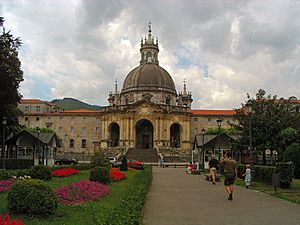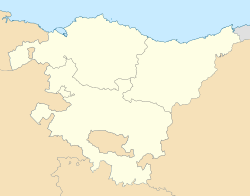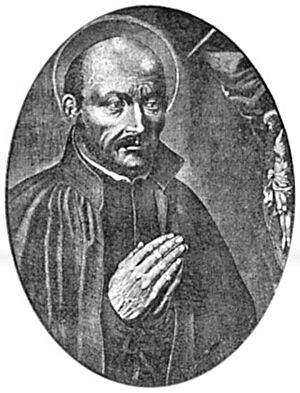Azpeitia facts for kids
Quick facts for kids
Azpeitia
|
|||
|---|---|---|---|

Sanctuary of Ignatius of Loyola, in Azpeitia
|
|||
|
|||
| Country | Spain | ||
| Autonomous community | Basque Country | ||
| Province | Gipuzkoa | ||
| Comarca | Urola Kosta | ||
| Founded | 1310 | ||
| Area | |||
| • Total | 210.12 km2 (81.13 sq mi) | ||
| Elevation | 80 m (260 ft) | ||
| Population
(2018)
|
|||
| • Total | 14,786 | ||
| • Density | 70.369/km2 (182.256/sq mi) | ||
| Demonym(s) | Basque: azpeitiarra | ||
| Time zone | UTC+1 (CET) | ||
| • Summer (DST) | UTC+2 (CEST) | ||
| Postal code |
20730
|
||
Azpeitia is a town and municipality in the Basque Country, Spain. Its name means 'down the rock' in the Basque language. The town is located on the Urola river in the province of Gipuzkoa. About 14,580 people lived there in 2014. It is about 41 kilometres southwest of Donostia/San Sebastián.
Azpeitia is famous as the birthplace of Ignatius of Loyola. His childhood home is now part of a large Jesuit building called the Sanctuary of Loyola. This place attracts many tourists and pilgrims. Azpeitia is also known for the Basque Railway Museum. The town sits at the foot of the huge Izarraitz mountain, which is a popular spot for locals.
Contents
What is the History of Azpeitia?
Azpeitia became an official town in 1310 by order of King Fernando IV. It was first called “Garmendia de Iraurgi.” A year later, its name changed to “Salvatierra de Iraurgi.” The name “Azpeitia” first appeared in 1397.
In the 13th and 14th centuries, there were many disagreements between important families in the town. These were mainly between the Oñatz and Gamboa families. In 1766, there was a local protest against King Carlos V's rules about selling wheat. This protest was quickly stopped by soldiers.
For a long time, the main jobs in Azpeitia were in the steel and wood industries. Today, the Sanctuary of Loyola and the Basque Railway Museum are popular places for visitors.
Who Was Saint Ignatius of Loyola?
Ignatius of Loyola was born in Loyola, Azpeitia, in 1491. He passed away in Rome in 1556. His family was part of the wealthy class in Biscay. When he was young, he worked for the ruler of Navarre.
In 1521, he was hurt in both legs during a battle in Pamplona. While he was getting better, he started reading religious books. This changed his life a lot. He then traveled to Catalonia, visiting the monastery of Montserrat in 1522. After that, he went to Manresa, where he spent a year thinking and meditating in a cave. During this time, he wrote his famous book, The Book of Spiritual Exercises.
After traveling to different cities, he went to Paris in 1528. There, he studied philosophy and theology. With some other students, he started the group that became the Society of Jesus, also known as the Jesuits. The Pope approved the Jesuits in 1540, and Saint Ignatius became their first leader. The Jesuits then spread across Europe and to the Americas. After his death, Saint Ignatius was made a saint by the Roman Catholic Church.
What is the Basque Railway Museum Like?
The Basque Railway Museum is located in the old Urola railway station. This station was once part of a train line that connected Zumaia and Zumárraga.
The museum has one of the best collections of trains in Europe. You can see many types of vehicles, including steam, diesel, and electric trains. There are also different kinds of passenger cars.
The museum also shows a complete set of old machine tools from the Urola Railway garage. This workshop looks just like it did when it opened in 1925. An old electric motor powers 16 machines using a complex system of pulleys and belts. Even though the old train line is no longer used for regular service, a special tourist train runs between Azpeitia and Lasao.
You can also see the amazing old electrical power plant. Its original equipment shows the advanced technology of a century ago. On the first floor of the main station building, there is a special display of train uniforms. These uniforms were used on railways from the late 1800s to modern times. The second floor has a large collection of railway clocks. Today, the museum is run by Eusko Tren, a public railway company.
How Did the Civil War Affect Azpeitia?
During a difficult time in Spain's history, Azpeitia experienced changes. People in Azpeitia had different ideas about the future of Spain. Some supported the Nationalists, while others supported the Republicans. There were also groups like the EAJ-PNV and other political groups.
In September 1936, Nationalist troops entered Azpeitia. After this, a new local government was formed. Azpeitia has always been known for speaking the Basque language, euskara. However, its use became less common during the time of Franco's rule. Franco himself visited the Loyola Sanctuary in Azpeitia in 1939 and 1945.
What Are Azpeitia's Historic Buildings?
The Emparan Tower House
The building of the Emparan Tower House started in 1320. It belonged to the Oñatz family, who were very powerful in the Basque Country. In 1456, the top part of the tower was taken down by order of King Henry IV. It was fixed in 1535. In 1750, many beautiful Baroque style details were added. The tower became a palace and looks much like it does today. Now, this historic palace is Azpeitia's public library.
The Hermitage of Our Lady of Olatz
This old chapel is located between Azpeitia and Loyola. It was built in the late 1200s and early 1300s. Inside, you can see a colorful Gothic statue of Our Lady of Olatz. It is said that Saint Ignatius had a special devotion to this statue. Important meetings for the Gipuzkoa region were held here until the early 1700s.
The Hospital and Hermitage of La Madalena
In 1535, after finishing his studies, Íñigo de Loyola (Saint Ignatius) came back to Azpeitia feeling unwell. Instead of staying in his family's grand home, he chose to live in this hospital and leper colony. He stayed with the sickest and poorest patients. He often preached there. People say he also walked the streets, asking for food and help for those who were ill, homeless, and unprotected. Today, the old hospital is used as a center to learn about Saint Ignatius.
The Church of San Sebastián de Soreasu
This church was built by the Templars between the 16th and 18th centuries. It was changed a lot over time, and only the tower from the original church remains. The old entrance was replaced in 1771 with a new design by Francisco Ibero. The church has eight chapels. The Baroque altarpiece and the baptismal font are especially beautiful. This is where Íñigo de Loyola was Christianized (baptized).
Who Are Some Famous People from Azpeitia?
- St. Ignatius of Loyola (1491–1556), who started the Society of Jesus (Jesuits) and became a Catholic Saint.
- Julián Elorza Aizpuru (1879-1964), a Spanish politician.
- José de Arteche (1906–1971), a Basque writer and biographer, born in Azpeitia.
Sport
- José Antonio Lopetegui (born 1930), a stone lifter (harri-jasotze).
- Xabier Azkargorta (born 1953), a footballer and manager.
- Juan Antonio Larrañaga (born 1958), a footballer.
- Jon Guridi (born 1995), a footballer.
Images for kids
See also
 In Spanish: Azpeitia para niños
In Spanish: Azpeitia para niños







